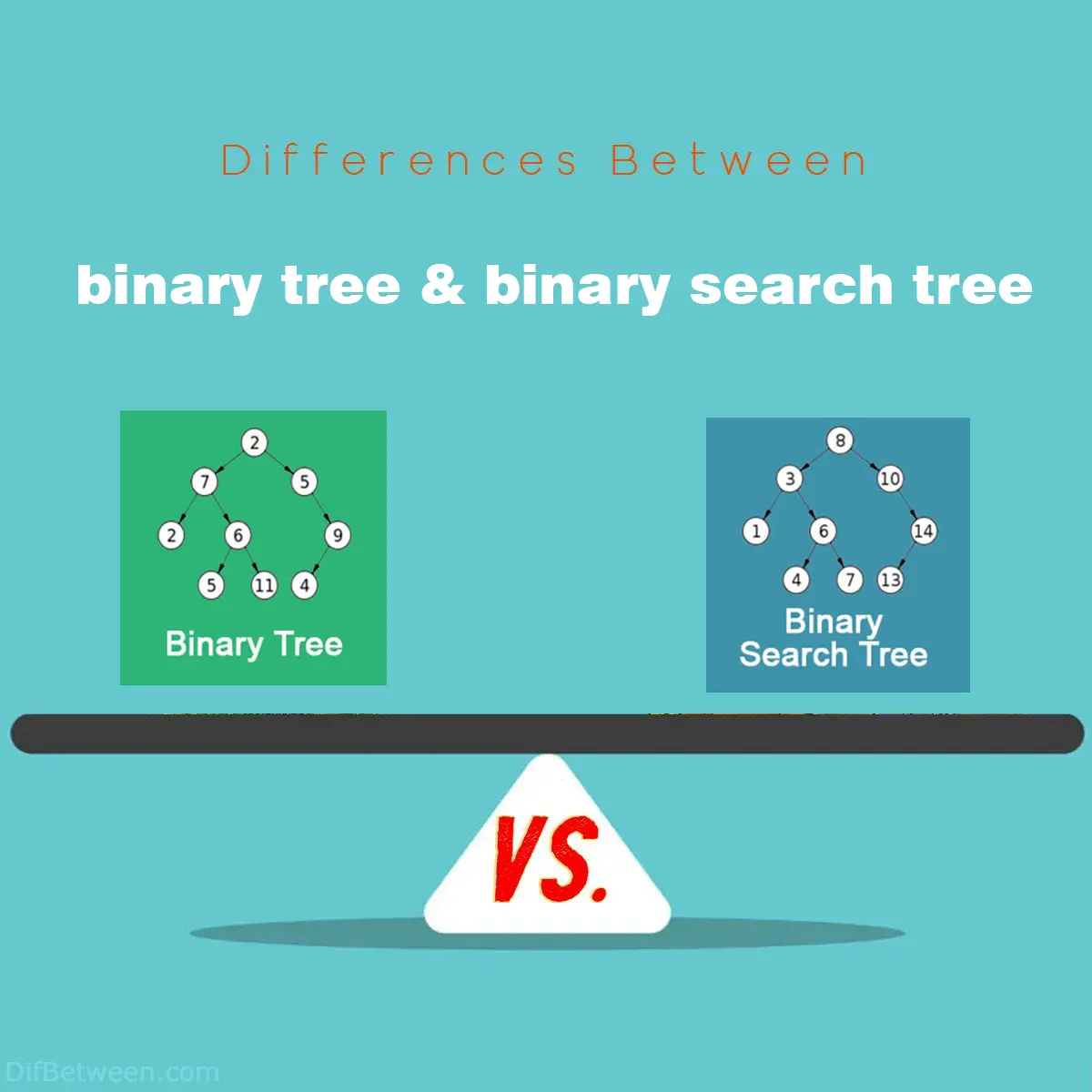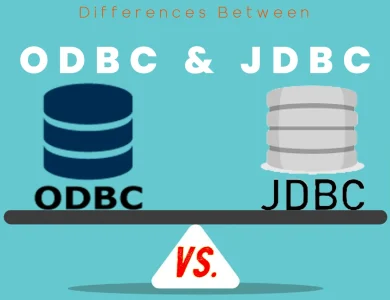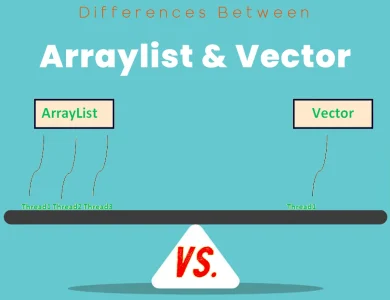
| Aspect | Binary Tree | Binary Search Tree |
|---|---|---|
| Structure | No specific order or arrangement | Follows a hierarchical value order |
| Searching Efficiency | Dependent on tree shape (O(n) worst-case) | Efficient (O(log n) average) |
| Insertion & Deletion | Freedom of placement, complex rearrangement | Follows hierarchy, balanced adjustments |
| Memory Footprint | Potential for redundancy, uneven memory use | Efficient, uniform memory usage |
| Balancing | Imbalance is common and can be complex to correct | Self-balancing through rotations |
| Tree Height | Varies widely, impacting traversal efficiency | Balanced height, optimized traversal |
| Inherent Order | No inherent order, random structure | Follows a natural sorted order |
| Usage Scenarios | Exploration, creativity, versatility | Organized data, efficient operations |
| Handling Imbalance | Complex, no universal solution | Self-balancing with rotation |
In the enchanting realm of data structures, two captivating entities reign supreme: the Binary Tree and the Binary Search Tree (BST). These structures might appear similar at first glance, with their branching nodes and hierarchical arrangements, yet they possess distinct characteristics that set them apart in the realm of computing. Imagine you’re on a journey through the digital forest, and I, your humble guide, shall shed light on the nuances that differentiate these two remarkable trees.
Differences Between Binary Tree and Binary Search Tree
The main differences between a Binary Tree and a Binary Search Tree lie in their structural order and data retrieval efficiency. A Binary Tree lacks a specific arrangement, allowing nodes to branch out randomly. In contrast, a Binary Search Tree follows a hierarchical order, with left nodes containing smaller values and right nodes holding greater values. The crucial disparity emerges in searching efficiency – while a Binary Tree’s search time can be influenced by its shape, a balanced Binary Search Tree ensures efficient searching with an average time complexity of O(log n).
1. Structure and Characteristics
Binary Tree: Behold the Binary Tree, a structure that captures the essence of simplicity. Picture it as a web of interconnected nodes, much like a family tree. Each node can have at most two child nodes, aptly named the left child and the right child. These nodes are not organized based on any particular order or rule – they simply exist in a branching pattern.
In this captivating web, nodes are like storytellers, each holding a piece of information. These nodes, while interconnected, don’t follow any particular arrangement, making traversal across the tree a potentially intriguing puzzle. A Binary Tree can have a single node at its core, known as the root node, which serves as the starting point for exploration.
Binary Search Tree (BST): Step into the realm of the Binary Search Tree, a more refined and organized version of its binary counterpart. Imagine a symphony of nodes that follow a harmonious rule – the nodes to the left of any given node hold values less than the node’s value, while those on the right hold values greater than the node’s value. This rule creates a natural hierarchy that allows for efficient data retrieval and manipulation.
The Binary Search Tree exudes elegance with its balanced nature. It strives to maintain equilibrium between its left and right subtrees, ensuring that the tree remains relatively flat and traversal times are optimized. This balance is maintained through rotations, a fascinating dance that nodes perform to uphold the tree’s equilibrium.
2. Searching for Treasures: Retrieval
Binary Tree: As you embark on your search for treasures within the Binary Tree, be prepared for an adventure. Since there are no strict rules governing node placement, each traversal becomes a unique experience. To find a specific value, you might need to explore the entire tree, hopping from one node to another like a curious explorer charting unfamiliar terrain.
In this structure, the time complexity of searching largely depends on the tree’s shape. In the worst-case scenario, if the tree resembles a linked list, searching can take O(n) time, where n is the number of nodes.
Binary Search Tree (BST): Ah, the Binary Search Tree offers a more refined approach to your quest. With its inherent order, finding a specific value is akin to a well-guided expedition. You start at the root, compare the target value, and based on the comparison, you swiftly navigate to the left or right child. This process repeats until you unveil the treasure – the sought-after value.
The beauty lies in the time complexity – the search operation in a balanced BST takes only O(log n) time on average, making it incredibly efficient. However, it’s important to note that an imbalanced BST can deteriorate into a linked-list-like structure, resulting in a worst-case time complexity of O(n).
3. Insertion and Deletion: A Shifting Landscape
Binary Tree: Insertion and deletion in the Binary Tree can sometimes feel like rearranging puzzle pieces without a clear picture. When adding a node, you have the freedom to attach it wherever you choose, be it as a left child, right child, or even further down the branches. This lack of rules can lead to trees with varying shapes, some compact and others sprawling.
Deletion can be equally complex. Removing a node involves reconfiguring the surrounding nodes to maintain connectivity, which might lead to unforeseen shifts in the tree’s structure.
Binary Search Tree (BST): Enter the Binary Search Tree, where insertion and deletion exhibit a dance of order. Adding a node involves adhering to the hierarchy – smaller values go to the left, and larger values to the right. This process maintains the tree’s balanced nature, ensuring efficient traversal times.
Deletion in a BST is a choreographed performance. When removing a node, the tree adjusts itself with precision, shifting nodes to fill the void while maintaining the hierarchy. It’s like trimming a bonsai tree to maintain its shape and balance.
However, a word of caution: carelessly inserting nodes can lead to an imbalanced BST, negating the advantages of efficient retrieval operations.
4. Memory Footprint: Space Efficiency
Binary Tree: In the realm of memory, the Binary Tree can be an extravagant guest. Each node carries its own baggage – the value it holds and references to its children. This can lead to redundant memory consumption, especially when nodes don’t have a consistent number of children.
Imagine a scenario where one node has two children, while another has only one. This non-uniform arrangement can result in memory inefficiencies.
Binary Search Tree (BST): Step in, Binary Search Tree, with your knack for optimizing space! Here, every node plays a role, contributing to a balanced and uniform structure. With each node having at most two children, the memory usage is streamlined, and there’s no excess baggage.
This efficiency extends to traversal algorithms, as the predictable structure allows for elegant recursive or iterative approaches.
5. Balancing Act: Tree Balance and Height
Binary Tree: In the realm of tree balance, the Binary Tree often ventures into the realm of chaos. With no constraints on node placement, the tree’s balance can sway to extremes. It’s not uncommon for a Binary Tree to resemble a lopsided tower, where one branch stretches skyward while the other barely grazes the ground.
This lack of balance brings about varying tree heights, which can impact the efficiency of traversal algorithms. Navigating from the root to the deepest leaf might require a multitude of steps, leading to suboptimal performance.
Binary Search Tree (BST): Ah, now consider the Binary Search Tree, a master of equilibrium. This tree strives to maintain a delicate balance between its left and right subtrees. As nodes are inserted and removed, rotations occur to ensure that the tree retains its equilibrium.
This pursuit of balance has a direct impact on the tree’s height. In a balanced BST, the height remains relatively low, allowing traversal algorithms to work their magic efficiently. However, should the tree become imbalanced due to poor insertion order, its height might shoot up, compromising the very efficiency it’s known for.
6. Inherent Nature: Sorted Order
Binary Tree: Behold the Binary Tree, a structure that embodies the spirit of randomness. Nodes are scattered without any inherent order, making each tree a unique mosaic of values. This inherent lack of organization makes the Binary Tree a versatile choice for scenarios where order is not a requirement.
While traversing such a tree can be akin to wandering through a wild forest, it can be a suitable option for certain applications where a strict ordering doesn’t matter.
Binary Search Tree (BST): Enter the Binary Search Tree, a guardian of sorted order. Each node in this tree follows a specific arrangement based on its value, creating a natural hierarchy. The left-child-right-child rule ensures that values on the left are smaller, while those on the right are larger.
This sorted order is a treasure trove for search operations. The BST leverages this order to optimize searching, insertion, and deletion, making it a go-to choice when these operations are frequent and efficiency is paramount.
7. Usage Scenarios: Where Each Shines
Binary Tree: Picture a scenario where creativity and chaos reign – this is where the Binary Tree thrives. When the goal is not about finding values quickly but exploring a wide array of possibilities, the Binary Tree offers an open canvas. Consider a decision-making process with multiple outcomes or a hierarchical representation that doesn’t require sorting – the Binary Tree is your companion.
Think of an organization’s reporting structure, where managers have varying numbers of subordinates. Each manager node can have a different number of child nodes, reflecting the real-world complexity of relationships.
Binary Search Tree (BST): Now, imagine a world where efficiency and order are prized – the Binary Search Tree takes center stage. In scenarios where data needs to be organized and retrieved swiftly, the BST’s structured elegance shines. A dictionary application that stores words and their meanings, a contacts list sorted by names, or a financial application managing transactions – these are realms where the BST’s optimized operations prove invaluable.
When efficiency and organization are non-negotiable, the Binary Search Tree stands as a steadfast choice, streamlining data management and retrieval.
8. Taming the Wild: Handling Imbalance
Binary Tree: When it comes to taming the wild within a Binary Tree, there’s no universal solution. Imbalance might creep in, and without a predefined structure, correcting it becomes a challenge. Reconfiguring nodes to regain balance requires careful consideration and might result in a significant overhaul of the tree’s architecture.
In scenarios where balance is not a priority or the tree is subject to infrequent changes, the Binary Tree’s unruly nature might be acceptable.
Binary Search Tree (BST): Ah, but in the world of Binary Search Trees, imbalance doesn’t hold sway for long. Thanks to rotations, an imbalanced BST can be gracefully restored to its ordered equilibrium. These rotations involve a choreography of node movements, ensuring that the hierarchy is maintained and balance is reestablished.
This ability to self-balance is a hallmark feature of the BST, ensuring that the efficient operations it promises remain intact even in the face of insertions and deletions.
Binary Tree or Binary Search Tree : Which One is Right Choose for You?
In the enchanting world of data structures, Binary Trees and Binary Search Trees (BSTs) stand as two distinct paths, each with its own allure and purpose. Choosing between them requires a clear understanding of your needs and the characteristics of these structures. Let’s embark on a journey of discovery to help you make the right choice for your digital endeavors.
When to Choose a Binary Tree: Embracing Creativity and Chaos
Binary Trees are like uncharted territories waiting to be explored. They revel in randomness and lack the rigid order of BSTs. Here’s when a Binary Tree might be the right fit for you:
- Exploration and Versatility: If your goal is to create a structure that encourages free exploration, a Binary Tree offers an open canvas. Consider decision-making scenarios with multiple outcomes or hierarchical representations that don’t require sorting. The unstructured nature of Binary Trees can mirror the complexity of real-world relationships.
- Diverse Node Relationships: In situations where nodes have varying numbers of children, a Binary Tree’s non-uniform structure can accommodate this diversity. Think of an organization’s management hierarchy, where managers oversee differing numbers of subordinates.
- Creative Problem Solving: Binary Trees invite creative problem-solving. If your application deals with scenarios that don’t demand strict order, such as game trees or exploring permutations, a Binary Tree can be a playground of possibilities.
When to Choose a Binary Search Tree: Efficiency and Order
Binary Search Trees (BSTs), on the other hand, are paragons of efficiency and order. They excel in scenarios where data organization and retrieval speed are paramount. Here’s when a BST might be your ideal choice:
- Efficient Searching and Sorting: If your primary concern is efficient searching, insertion, and deletion of data, a Binary Search Tree’s inherent order can significantly speed up these operations. Applications such as dictionaries, contact lists, or financial systems benefit from the optimized retrieval offered by BSTs.
- Ordered Data Storage: When you need to store data in a sorted manner, a BST becomes your loyal companion. Think of situations where you want to maintain an alphabetical list of names or a chronological record of events.
- Balanced Hierarchy: For applications where maintaining a balanced hierarchy is crucial, BSTs shine. Their self-balancing nature ensures that traversal operations remain efficient, even with frequent data changes.
Making the Decision
In the Binary Tree vs. Binary Search Tree dilemma, your choice hinges on your specific needs. If your digital journey embraces unpredictability, creative exploration, and scenarios where order isn’t a priority, the Binary Tree’s charm might be your calling. On the other hand, if efficiency, ordered data storage, and optimized operations are your goals, the Binary Search Tree’s structured elegance beckons.
As you stand at this crossroads, consider your application’s landscape, data requirements, and the operations you’ll perform most frequently. Embrace the uniqueness of each structure, for within their differences lie the keys to unlocking their full potential. Whether you’re drawn to the Binary Tree’s labyrinthine allure or the Binary Search Tree’s orchestrated grace, your choice becomes a cornerstone of your digital journey, shaping the way you interact with data and weave your computational tapestry.
FAQs
A Binary Tree is a data structure composed of nodes connected in a hierarchical manner. Each node can have at most two children, typically referred to as the left child and the right child.
A Binary Search Tree is a specialized type of Binary Tree with a key property – the values in the left subtree are smaller than the root, and the values in the right subtree are greater. This order allows for efficient data retrieval.
The main difference lies in their organization and data retrieval efficiency. A Binary Tree has no specific order, while a Binary Search Tree follows an order that optimizes searching operations.
Binary Trees are suitable for scenarios where creativity and exploration are valued over strict order. They work well for representing diverse relationships, game trees, and decision-making processes.
Choose a Binary Search Tree when efficient searching, insertion, and deletion of data are essential. They are ideal for applications that require organized data storage and quick retrieval, such as dictionaries or contact lists.
A balanced Binary Search Tree ensures that traversal operations are efficient. It maintains a relatively low height through self-balancing mechanisms, which optimizes data manipulation operations.
Yes, a Binary Tree can be transformed into a Binary Search Tree by rearranging its nodes to adhere to the BST property. However, this process might involve substantial changes and could impact the original data distribution.
Balancing a Binary Tree can be complex. Techniques like AVL trees or Red-Black trees can be used to maintain balance, but implementation requires careful consideration.
A Binary Search Tree is generally more memory-efficient due to its balanced structure. Each node has at most two children, leading to uniform memory usage.
While it’s possible, using a Binary Search Tree for unordered data might negate its efficiency advantages. In such cases, a regular Binary Tree might be more suitable.
Read More :
Contents
- Differences Between Binary Tree and Binary Search Tree
- 1. Structure and Characteristics
- 2. Searching for Treasures: Retrieval
- 3. Insertion and Deletion: A Shifting Landscape
- 4. Memory Footprint: Space Efficiency
- 5. Balancing Act: Tree Balance and Height
- 6. Inherent Nature: Sorted Order
- 7. Usage Scenarios: Where Each Shines
- 8. Taming the Wild: Handling Imbalance
- Binary Tree or Binary Search Tree : Which One is Right Choose for You?
- FAQs






